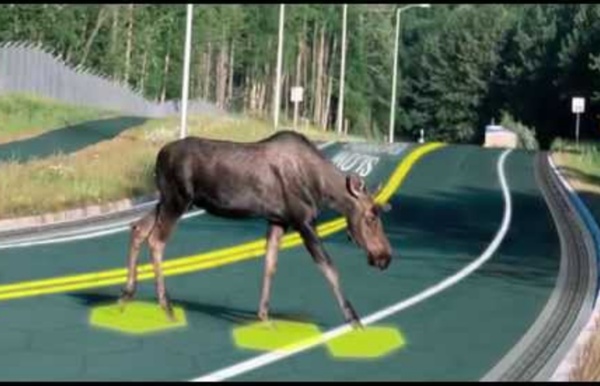



How Maglev Trains Work If you've been to an airport lately, you've probably noticed that air travel is becoming increasingly congested. Despite frequent delays, airplanes still provide the fastest way to travel hundreds or thousands of miles. Passenger air travel revolutionized the transportation industry in the last century, letting people traverse great distances in a matter of hours instead of days or weeks. The only alternatives to airplanes -- feet, cars, buses, boats and conventional trains -- are just too slow for today's fast-paced society. A few countries are using powerful electromagnets to develop high-speed trains, called maglev trains. Electromagnetic Suspension (EMS) If you've ever played with magnets, you know that opposite poles attract and like poles repel each other. The magnetic field created in this wire-and-battery experiment is the simple idea behind a maglev train rail system. In the next section, we'll take a closer look at the Maglev track.
Solar Roadways passes $1.4 million in crowdfunding: Just short of the $56 trillion required, but not bad for a crazy idea Over the weekend, the Solar Roadways project on Indiegogo reached its target of $1 million. At the time of publishing, that figure is now north of $1.4 million, with five days left to go. The concept is verging on utopian: By replacing the USA’s concrete and asphalt roads with solar panels, we could produce three times more electricity than we consume, instantly solving just about every energy problem we have (geopolitical stuff, reliance on fossil fuels, CO2 production, etc.) It’s not hard to see why Solar Roadways has attracted so much attention and money: On paper, it really does sound like one of the greatest inventions ever. In reality, though, where, you know, real-world factors come into play, it will probably never make the jump from drawing board to large-scale deployment. Solar Roadways, the brainchild of Julie and Scott Brusaw of Idaho, have been in development since at least the mid-2000s. The top piece of tempered glass on a Solar Roadways panel
Why The Solar Roadway Is A Terrible Idea Recommended by Jason Torchinsky Congrats to Jason Torchinsky and Neal Pollack of Yahoo! Autos for n... Hypermiling Is Awful And I Sort Of Hate It [Jason decided to modify his Audi A3 TDI to get maximum fuel mileag... I'm Trying To Go 834 Miles On One Tank Of Diesel And It's Gonna Suck The White Stripes -- Fell In Love With A Girl Did This Online Auction Reveal Preston Tucker's Never-Made Roadster? PETA Is Pissed At Google For Making A Camel Do A Jeep's Job This Simple, Goofy Idea Makes For A Great Car Tumblr Why Are Cars Almost Always Symmetrical? Jalopnik Is Ten! Let's Add Cars To Old Landscape Paintings Check Out The Jalopnik Line Of Super-Sexy Halloween Carstumes! Holy Crap, NASA Is Considering Improvements To Orion That We Proposed A Driverless Audi RS7 Will Do A Lap At A German Touring Car Race Meet Uruguay's Amazing Stillborn Frankenstein Sportscar, The Ultra SP Someone Spray Painted A Dick On The Hood Of A Veyron First Ever Inflatable Space Station Module Set To Launch Next Year
World's First Solar Cycle Path Installed In Amsterdam Earlier this year, we heard of a dynamic duo’s ambitious project, Solar Roadways, which wants to replace concrete roads, driveways and parking lots in the US with their innovative solar panels. But it turns out that they’re not the only ones that think this green idea is a smart idea, as a group in the Netherlands has just designed and installed the world’s first solar cycle path. The path, which was developed by the Netherlands’ TNO Research Institute, runs between the suburbs of Krommenie and Wormerveer. The busy 70-meter stretch serves some 2,000 cyclists per day, and is set to open next week (November 12). 70 meters might not sound like much, but it’s a proof-of-concept pilot project to test feasibility and practicality, and it makes sense to test the waters on roads that are occupied with lightweight bicycles rather than hefty vehicles. The SolaRoad was made using prefabricated slabs consisting of concrete blocks topped with a translucent layer of tempered glass. SolaRoad